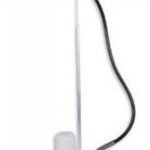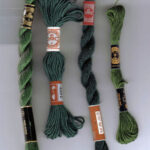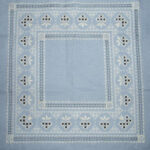There are two ways in which tatting can be mounted for use on clothing and items such as bags, towels and so on. One is as an edging, the other is as applique. In the latter form, it can almost take on the appearance of embroidery.
The most common use for tatting on clothing in the old books and magazines has been as an edging on a garment such as a blouse. There are two problems here. One is that the tatting has to be made to fit the edge it is to be applied to. This is not always easy as modern necklines and sleeves are much bigger than they used to be. It is always advisable to have the garment to which the tatting is to be attached available so that you can double check your measurements and adjust as the lace is being made.
The actual mounting is very simple. Just take a double stitch through each picot, attaching it to the fabric with the stitching. It does not take a great deal of time to do and looks very pretty indeed.
The only difficulty with tatting applied as an edging to a garment or item that is to be washed frequently is the fact that it must stand up to washing. Loosely worked tatting can get very stringy and picots also get very untidy. Tatting applied as an edging to a garment should be worked crisply, and there should not be too many free picots in the lace.
It is advisable in fact to remove the tatting from the garment each time it is washed and re-attach it when the garment has been pressed. The tatting should in any case not need washing nearly as often as the garment and should, carefully looked after, outlast the item on which it has been mounted, ready for use on another item. This may sound a pain, but you took time to make the lace and it is worth looking after it. I have a collar I made some years ago. It has been worn on a number of occasions on my best dress, and still looks like new. The dress has been washed several times and on each occasion the collar was removed for washing.
Another, easier way is to use the tatting as applique. Tatting takes on an almost embroidered look when used in this way and I have seen some rather exciting effects. At the Surrey Tatters Garden Party last year one of the ladies had a wonderful top with the butterfly from New Dimensions in Tatting appliqued to it and it looked absolutely fantastic.
There are two things to remember. One is that ABSOLUTELY EVERY PICOT must be stitched down to the fabric. This takes time but will ensure the lace stays in shape throughout the life of the garment – again it should outlast the garment. The other is to use good quality thread – it will have to withstand regular washing and you should test it to make sure it is color fast before making your lace. Deep purple and red are colors which are particularly bad for running and you will be very disappointed if, when you come to wash the garment on which you have applied your tatting, the color runs all over it leaving it an unwearable mess. Also make sure the garment itself is color fast – wash it with a white item before mounting the tatting.
If you use beads in the tatting, make sure they are washable however you plan to wash your garment – if in the washing machine they will need to withstand this. Remember that beads too are not always color fast.
It’s possible to make clusters of rings and use rings and chains in pictorial freehand tatting to form very effective appliques, again you will need to mount these with invisible stitches. There is a picture in Mary Konior’s Tatting with Visual Patterns of tatting which has been dyed and mounted on knitted fabric. It looks almost like an oil painting.
I’ve run out of space for this week, so we will consider the next technique – sewing your tatting to a background using buttonhole stitch – next week. Please make sure you have a compass (the same tool your children use to draw circles at school) and pencil ready, together with some cardboard and a length of tatted edging suitable for mounting onto a circular mat. Don’t make it too big – about 4-6 inches in diameter inside the edging is fine.






